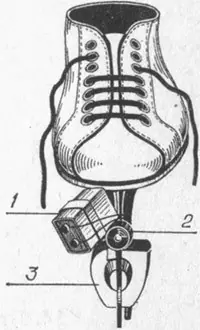We have previously talked about some simulators and training devices for modern speed skaters. In this article we will look at another extremely useful device that is actively used by these athletes around the world. The principle of its operation is extremely simple, but its efficiency is beyond all praise. It is not for nothing that speed skaters from all leading countries have long adopted it and practice regular training using it.
Well... Let's figure it out - what kind of miracle device is this?
There are two types of podoscope available: with sound and light signals. Both devices allow you to inform skaters when placing their skate on the ice. With the help of the simulator, it becomes possible to train and improve the rhythmic characteristics of distance running for speed skaters of any qualification.
Podoscope with light signal (Fig. 1) consists of a battery 1, a light bulb 2 and a contact device 3. The contact device is a platform made of insulating material. The device easily fits onto the skate tube and fits tightly to it. A rubber gasket with a metal contact is mounted on the outside of the platform, which, when in contact with the blade of the skate, closes the circuit.
At the top of the platform there is a thin metal crimp through which current is transmitted to the ridge. Such contact devices are fixed on both skates, and when the skate is placed on the outer edge, the light comes on. When training at the skating rink in the evening, the light of a light bulb is visible.
Podoscope with sound signal allows you to inform skaters about placing a skate on the ice in any lighting conditions. A contact device is built into the device, from which wires go to a sound generator mounted on the athlete’s back with a belt, and then to an earphone attached to the skater’s cap.
When placing the skate on the outer edge and throughout the entire period of gliding, a signal sounds on the outer edge. Information about the correct positioning of the skate can prevent errors in the technique of running in a straight line (counter support).
Post Views: 117


